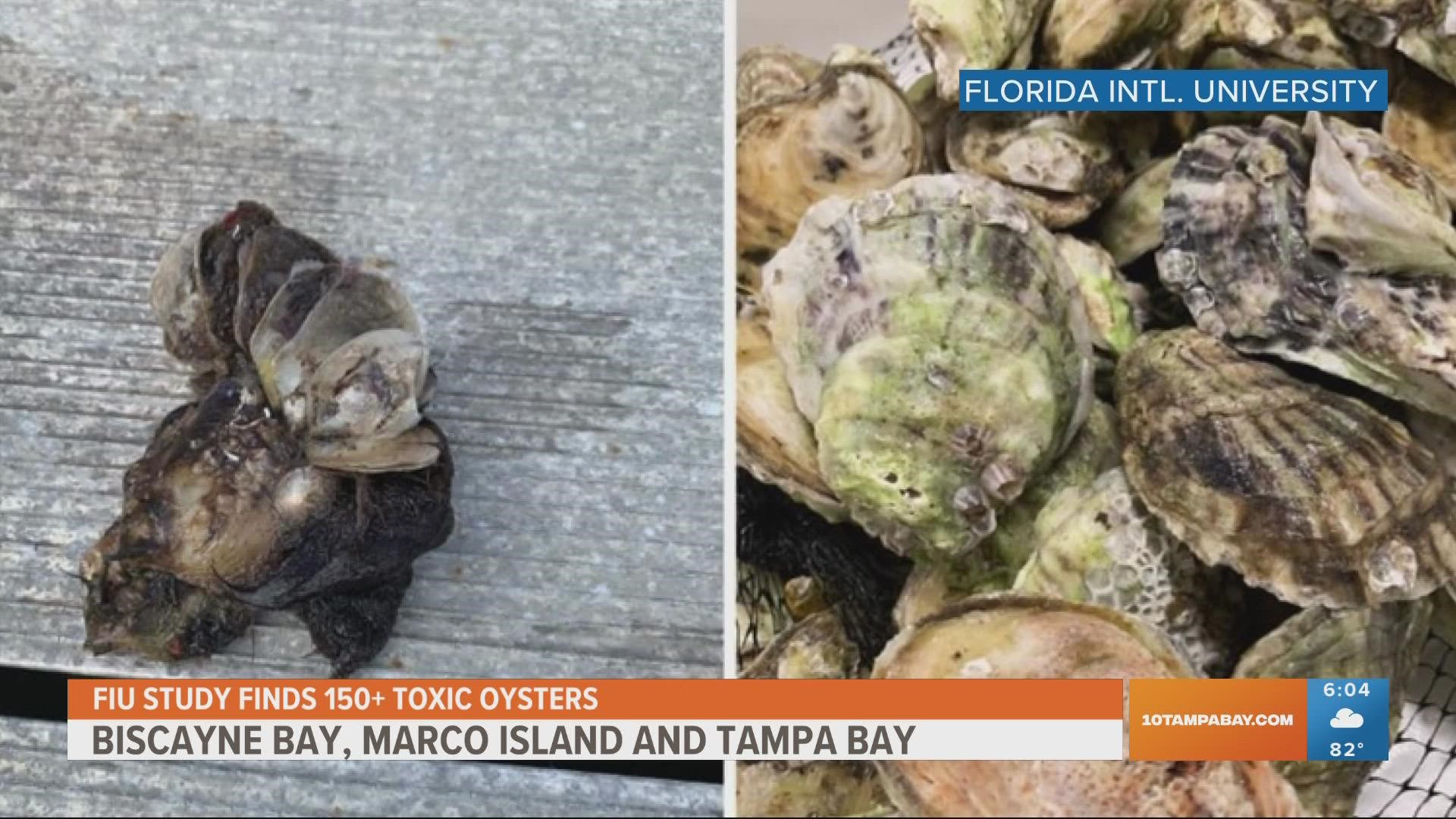TAMPA, Fla. — A study done by scientists from Florida International University found that oysters sampled from major areas around the state contained toxins potentially harmful to humans and wildlife.
The study detailed the findings of 156 oysters taken from Biscayne Bay, Marco Island and Tampa Bay. It was determined that every single oyster contained the contaminants perfluoroalkyl and polyfluoroalkyl (PFAS) and phthalate esters (PAEs).
"These contaminants pose serious health risks to people and wildlife, and the oysters prove they are in the water and have crept into the food chain," the study states.
The study's lead author and an FIU distinguished postdoctoral scholar Leila Lemos said in a statement that the findings were "definitely a red flag."
According to researchers, oysters are a great indicator of the health of the ecosystem because they are filter-feeders.
The study indicates that oysters from Biscayne Bay contained the highest concentrations of the contaminants, which could be affecting the oysters' growth and development.
"The number of contaminants in the area could impair their development, which raises concerns for how chemical contaminants could threaten oyster farming in other parts of the country," the study claims.
Ways of Exposure
Unfortunately, researchers believe there are many ways that oysters can come in contact with these contaminants. The study explained that even drinking water can contain both PFAS and PAEs.
PAEs can be found in:
- Consumer products
- Including pharmaceuticals
- Cosmetics
- Personal care products
- Food packing
- Detergents
- Children’s toys and more
FIU scientists state that "exposure can happen from ingestion, inhalation, and through contact with dirt or soil, and studies have found association between PAE exposure and diabetes, obesity, allergies and asthma, as well as impacts to reproductive health, immune function and more."
PFAS can be found in:
- Man-made chemicals, primarily used in industrial and consumer products.
- Fast food packaging
- Non-stick cookware
- Waterproof makeup
- Clothing
- Adhesives
- Firefighting foams and more
The study states that "PFAS are problematic because they accumulate over time in the water, air, soil and have even been found in human blood."
According to the scientists at FIU, these chemicals are known to impact reproduction and human development, immune system functioning, interfere with the effectiveness of vaccines, as well as cause liver and kidney damage.
The Environmental Protect Agency (EPA) warned that PFAS are more dangerous than previously thought, even at undetectable levels, the study explains.
The problem doesn't end with oysters
The discovery of contamination of marine wildlife doesn't end with oysters. Earlier this year, Florida International University and Bonefish & Tarpon Trust announced the results of a three-year study, finding that a sample of 93 bonefish in South Florida each contained an average of seven pharmaceutical contaminants. The fish were collected in saltwater areas of Biscayne Bay near Miami and the Florida Keys.
One fish, researchers say, had 17 different types of drugs in its system, including blood pressure medication, antidepressants, prostate treatment medications, antibiotics and pain relievers. Other noted drugs in researchers' findings include heart medications, antifungal medication and opioids.
"These findings are truly alarming," said Jennifer Rehage, the lead researcher and a coastal and fish ecologist and associate professor at the FIU Institute of Environment, in a statement. "Pharmaceuticals are an invisible threat, unlike algal blooms or turbid waters.
"Yet these results tell us that they are a formidable threat to our fisheries, and highlight the pressing need to address our longstanding wastewater infrastructure issues."
Crabs, shrimp and other fish — animals that eat bonefish — also were found to have drugs in their systems. These findings pose a significant threat to the state's flats fishery, which supports more than 88,500 jobs and has an annual economic impact of $9.2 billion, said Jim McDuffie, the president and CEO of Bonefish & Tarpon Trust.
Pharmaceuticals in area waterways and the drinking supply have been a major concern for years, according to the U.S. Geological Service. Drugs largely pass through the body unchanged and go down the toilet as waste, but sewage treatment plants cannot separate out the pharmaceuticals. That water, since treated into another product, then ends up as fertilizer or empties into larger bodies of water.
The FIU and Bonefish & Tarpon Trust researchers say the drugs still remain active at low doses and can affect fish feeding, activity, sociability and migratory behavior.

